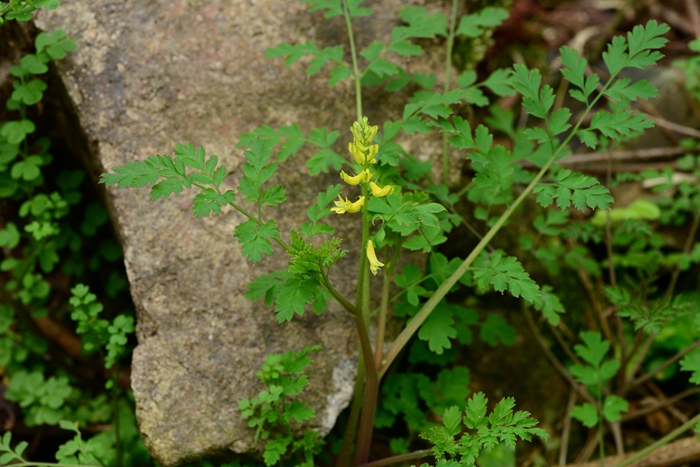- Scientific Name: Corydalis racemosa (Thunb.) Pers.
- Ref: Syn. Pl. 2:270. 1806
- Synonym: Capnoides racemosa Kuntze; Corydalis fumaria H.Lév. & Vaniot; Fumaria racemosa Thunb.
- Chinese Common Name: 小花黄堇 xiǎohuā huángjǐn
- Japanese Common Name: ホザキキケマン [穂咲黄華鬘] hozakikikeman
- Family: Papaveraceae
- Genus: Corydalis
- Distribution: Shaded forest margins, stony brook sides, thickets, also as a weed in wastelands, even along roadsides in cities; 400-2000 m. Anhui, Fujian, Gansu, Guangdong, Guangxi, Guizhou, Henan, Hubei, Hunan, Jiangsu, Jiangxi, Shaanxi, Sichuan, Taiwan, Xizang, Yunnan, Zhejiang [Japan].
- Photo: Wenzhou, Zhejiang
Herbs, summer annual, 20-50 cm tall, with thin taproot. Stems ridged, leafy, much branched, weak, diffuse. Basal leaves long petiolate, often early withering. Cauline leaves petiolate; blade gray abaxially, green adaxially, deltoid, bipinnate with 3 or 4 pairs of distant shortly stalked pinnae; secondary pinnules 1 or 2 pairs, ovate to broadly ovate, ternately divided; ultimate segments rounded-obtuse, slightly mucronate. Raceme 3-10(-15)-flowered, dense at first, elongating in fruit; bracts lanceolate to subulate, 3-5 mm, margin scarious, apex acuminate to mucronate. Pedicel 3-5 mm. Flowers yellow to pale yellow. Sepals caducous, ovate, small. Outer petals obtuse or acute, without or with very narrow slightly dentate crest; spur broadly saccate, ca. 2 mm; nectary extended through ca. 1/2 of spur; inner petals 6-7 mm, with dorsal crest shortly overtopping apex. Stigma bifid, lobes narrow, reflexed-geniculate with 2 papillae flanking apical division, one terminating each lobe, and each lobe usually with a pair of submarginal geminate lateral papillae. Capsule straight, linear, 20-30 × ca. 1.5 mm. Seeds black, rounded in profile, with concentrically arranged small tubercles. Fl. and fr. Feb-Sep. (Flora of China)
